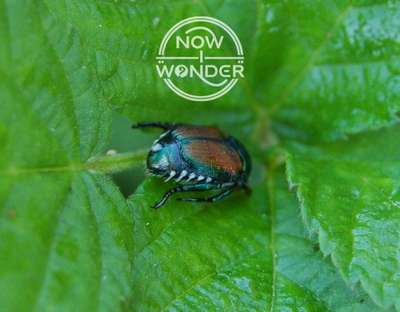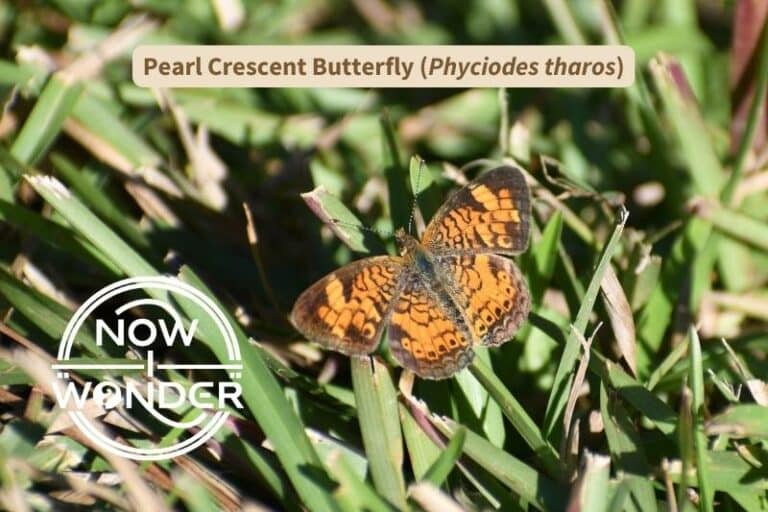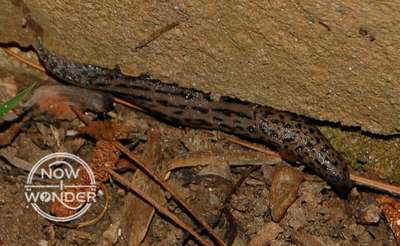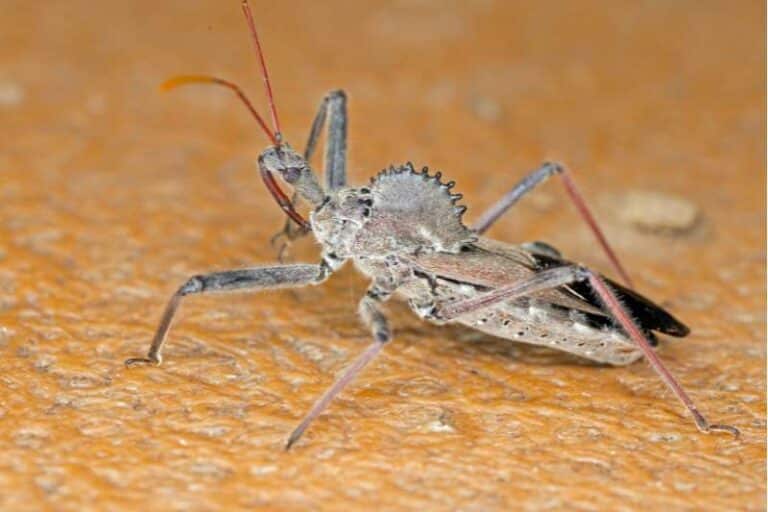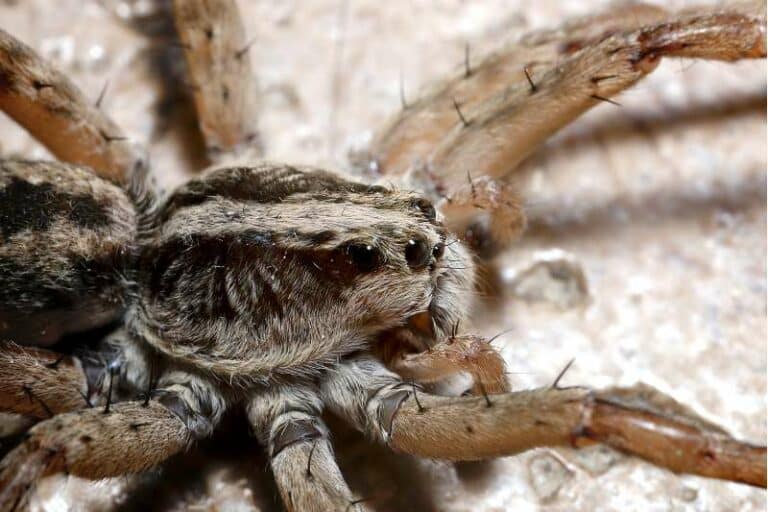Found throughout North Carolina, Silver-spotted Skipper butterflies (Epargyreus clarus) are brown and named for the large silver patch on the underside of their hindwings. The caterpillars feed at night, construct leaf shelters, and shoot excrement away to avoid predators that hunt by scent.
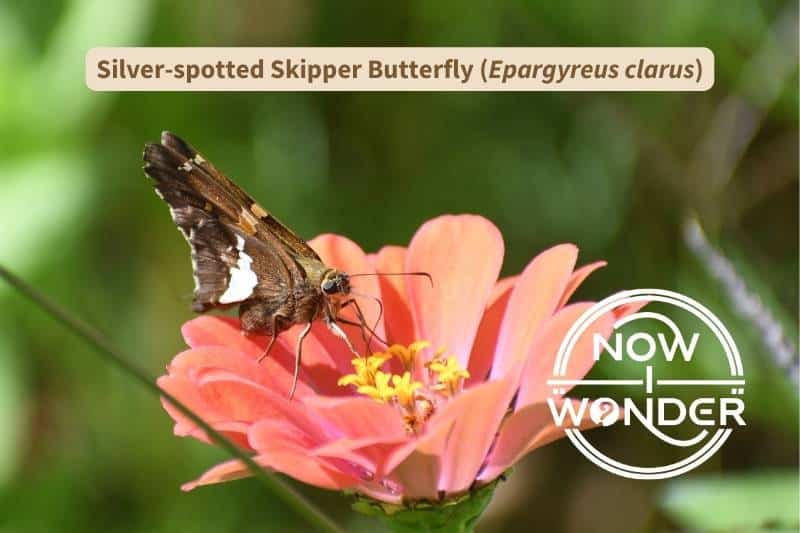
Fun Facts About Silver-spotted Skipper Butterflies to Wow Your Friends
My absolute favorite thing to do after I identify a butterfly is to learn everything I can about it.
Every species on earth is unique and has its own quirks, hidden talents, enemies, and friends. I call these special tidbits “fun facts” because that’s what they are to me.
Here are a few fun facts about Silver-spotted Skipper butterflies that I hope you enjoy too!
- Silver-spotted Skipper caterpillars feed on an invasive weed called Kudzu (Pueraria montana).
- Kudzu was originally imported from Japan in 1876 for use as a landscape plant.
- But the vine quickly spread beyond human control. Now, it engulfs entire stands of trees across the eastern United States.
- Unfortunately, Kudzu is an incredibly aggressive vine.
- Silver-spotted Skippers don’t limit its growth in North Carolina’s wild spaces. But it’s nice to know that some creature is benefiting from Kudzu’s presence.
- Silver-spotted Skipper caterpillars shoot their excrement.
- Silver-spotted Skipper caterpillars have a toothed plate called an “anal comb” above their anuses.
- The anal comb acts as a latched door at the end of the caterpillars’ digestive system and blocks digested food (called “frass”) from being excreted.
- When ready to excrete, a Silver-spotted Skipper caterpillar raises the insect equivalent of its blood pressure in its hind end rapidly. This presses the frass pellet hard against the closed anal comb. When the pressure gets high enough, the comb pops open and the frass shoots out of the caterpillar.
- The expulsive force is so powerful it can launch a frass pellet up to 38 body lengths away from the caterpillar (Weiss 2003).
- Shooting their frass long distances is an evolved defense mechanism against dangerous creatures like parasitic wasps. Parasitic wasps might otherwise zero in on the caterpillars’ location by smelling their excreta..
But fun facts are a whole lot more fun when you get to see the actual animal in real life. So read on to find out where, when, and how to find Silver-spotted Skipper butterflies in North Carolina, and how to make sure you’re looking at the animal you think you are. You’ll be so glad you did!
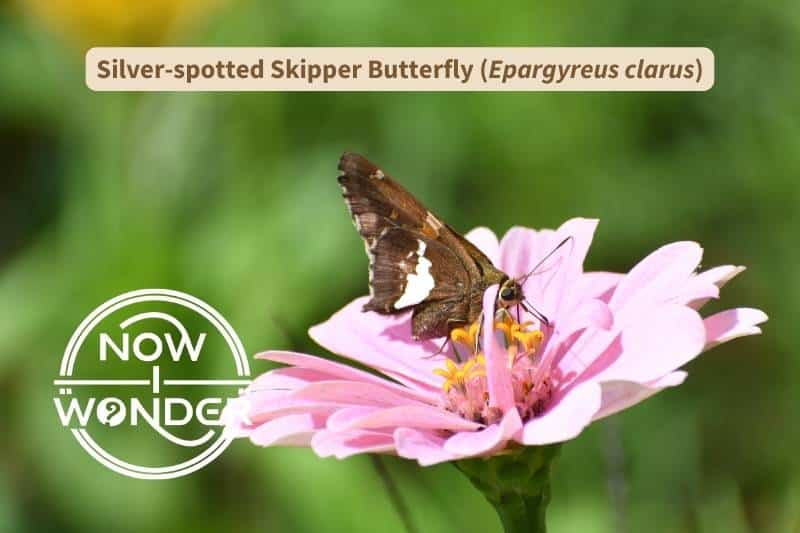
How Are Silver-spotted Skippers Classified?
| Kingdom | Animalia |
| Phylum | Arthropoda |
| Class | Insecta |
| Order | Lepidoptera |
| Family | Hespiriidae (“true skippers”, subfamily Pyrginae (“spreadwing skippers”)) |
| Genus species | Epargyreus clarus |
How Do I Know I’m Looking At A Silver-spotted Skipper Butterfly?
Appearance of Silver-spotted Skipper Butterfly Eggs
Female Silver-spotted Skippers lay their round, green eggs one at a time on the leaves of their host plants.
Appearance of Silver-spotted Skipper Butterfly Caterpillars / Larvae
You’ll know you’re looking at a Silver-spotted Skipper caterpillar when you see a short, fat caterpillar approximately 1.4 inches (3.5 cm) long with two distinguishing characteristics.
First, the caterpillar’s body will be wrinkled, with alternating bands of sulphur-yellow and green along each body segment. It will have no spines or protuberances but will be covered with very short, nearly invisible bristles (Wagner 2005).
Second, the caterpillar’s head will look like a large reddish-brown ball stuck onto its body by a narrow neck. Nearly all skipper caterpillars share this unmistakable head shape and thin neck arrangement. Silver-spotted caterpillar heads are distinguished by a pair of large orange spots on front of their heads (Wagner 2005).
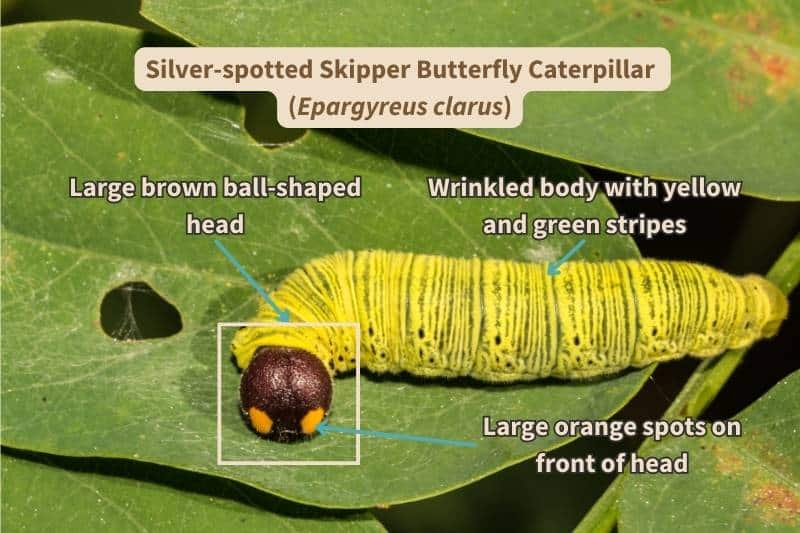
Silver-spotted Skipper caterpillars can be pretty easy to find in the wild. The species is widespread across North Carolina and they feed on a wide variety of plants. Like nearly all skipper species, they feed at night. During the day, they hide in shelters made by anchoring flaps of cut leaves together with silk.
On the other hand, Silver-spotted Skipper chrysalids are hidden in leaf litter and camouflaged in shades of brown.
Appearance of Adult Silver-spotted Skipper Butterflies
As a whole, skipper butterflies are notoriously difficult to identify to species. But Silver-spotted Skippers are distinctive and thus easily recognized, which gives amateur naturalists some hope.
Silver-spotted Skipper butterflies are mostly brown, with wing spans of about 2.4 inches (6 cm). Their bodies are dark brown and fuzzy. Their abdomens (otherwise known as their hind ends) are short and fat compared to other butterfly species. They have large brown eyes and the hooked antennae characteristic of butterflies in the skipper family Hesperiidae.
You’ll know you’re looking at a Silver-spotted Skipper butterfly when you see a brown butterfly with a wing span of about 2.4 inches (6 cm) decorated with a large, irregular patch of silver scaling on the underside of its hind wing.
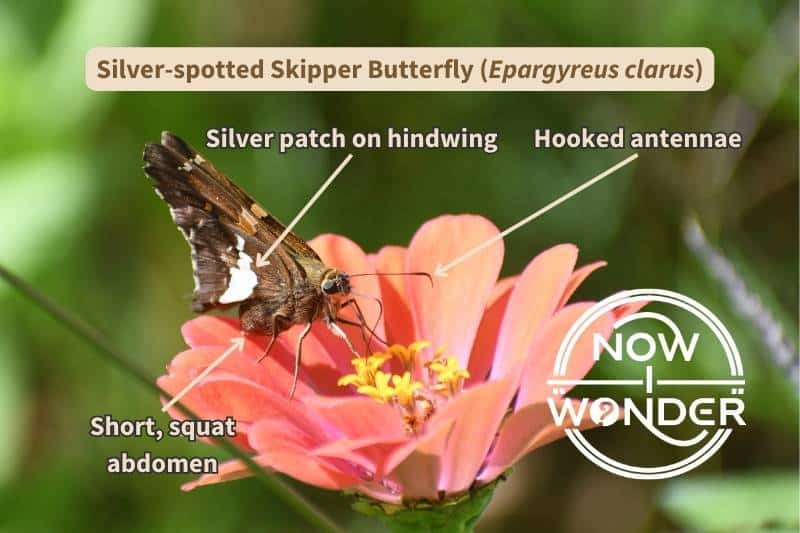
Although Silver-spotted Skimmers are classified as “spread-wing skippers” in subfamily Pyrginae, they usually perch with their wings closed unless basking in the sun.
The top surface of their forewings looks uniformly brown at first glance. But a transparent orange band appears when sunlight strikes the wings at just the right angle.
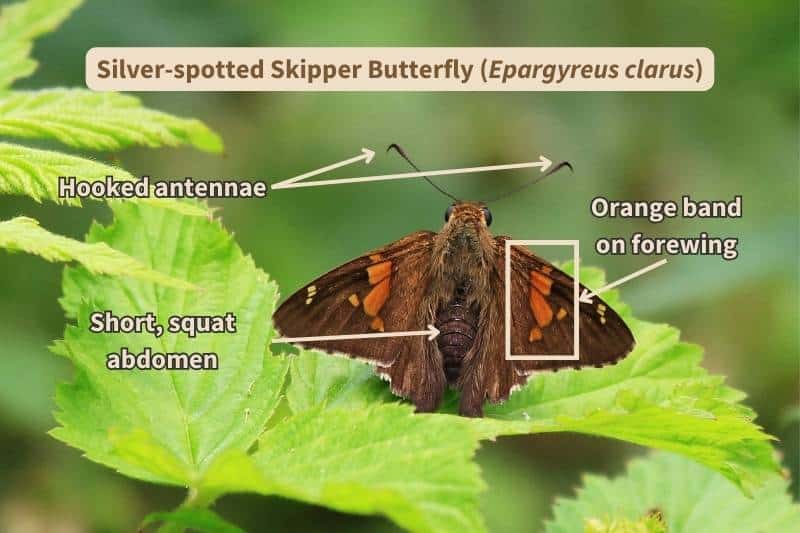
When Can I Find Silver-spotted Skipper Butterflies in North Carolina?
Silver-spotted Skipper butterflies fly during the summer season, although their flight season is slightly shorter than other species.
In North Carolina, individuals survive the winter months as caterpillars. Starting around late April, they pupate into adult butterflies. They fly through mid-October, depending on when and how quickly the fall temperatures drop.
Where Should I Look To Find Silver-spotted Skipper Butterflies in North Carolina?
Silver-spotted Skipper butterflies are one of the easier species to spot in North Carolina as they live in a wide variety of habitats throughout the state.
Look for these butterflies along the edges of woods, near streams, lakes, and ponds, in flower gardens, and in grassy meadows. Males are territorial and often perch on low vegetation so they can watch for females and intruding males (Brock and Kaufman 2006). Sometimes, Silver-spotted Skipper butterflies will fly out to investigate passing humans.
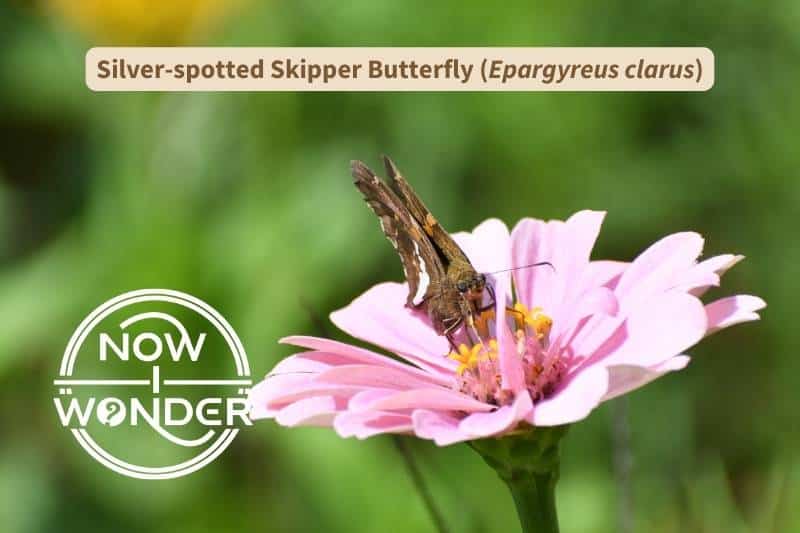
What Do Silver-spotted Skipper Butterflies Eat?
Silver-spotted Skipper Larval Food Plants
Silver-spotted Skipper caterpillars feed on a wide variety of plants in the pea family Fabaceae.
- In North Carolina, plants in this family include:
- Bush Clover (Lespedza spp)
- False Indigo (Amorpha fruticosa)
- Kudzu (Pueraria montana)
- Groundnut (Apios americana)
- Butterfly Pea (Clitoria mariana)
- Wisteria (Wisteria frutescens)
Plant choice by caterpillars has a huge impact on the ultimate success of the adult butterflies. The nutrition caterpillars take in before they pupate carries forward into their adult forms. Better-fed caterpillars become bigger, stronger, and more fertile butterflies.
This is especially true for Silver-spotted Skippers who are almost ready to pupate and metamorphose into butterflies. During this stage (referred to as an “instar”), Silver-spotted Skippers “consume 12 times more food in the final (5th) instar that they do in all the other instars combined” (Rosenwald et al. 2017).
Another major food plant for Silver-spotted Skipper caterpillars is the Black Locust (Robinia pseudoacacia). Unlike kudzu and wisteria, Black Locust trees are native to North Carolina. This means that Silver-spotted Skippers have a much longer evolutionary history with Black Locusts than with kudzu and wisteria, which are both invasive, non-native plants.
In a terrific study published in the journal Plant-Arthropod Interactions, Silver-spotted Skipper caterpillars preferred to feed on Black Locusts over both Kudzu and Wisteria when given a choice. Wisteria was the least preferred food of the three. Wisteria has the lowest nitrogen and water content of the three plants. This makes it a low nutrition food compared to the other two options.
Even their second choice, Kudzu, helped the caterpillars gain 50% more mass than the caterpillars who fed on Wisteria the whole time (Rosenwald et al. 2017).
Adult Silver-spotted Skipper butterflies drink nectar from a wide variety of flowers. They have long probosces so can access nectar from flowers whose nectaries are too deep for some other butterflies to reach.
References
Brock, Jim P., and Kaufman, Kevin. 2006. Kaufman Focus Guides: Butterflies of North America. Houghton Mifflin Company.
Rosenwald, Laura C., John T. Lill, Eric M. Lind, and Martha R. Weiss. 2017. “Dynamics of Host Plant Selection and Host-Switching by Silver-Spotted Skipper Caterpillars.” Arthropod-Plant Interactions 11 (6) (12): 833-842. doi:https://doi.org/10.1007/s11829-017-9538-0.
Wagner, David L. 2005. Princeton Field Guides: Caterpillars of Eastern North America. Princeton, NJ: Princeton University Press.
Weiss, Martha R. 2003. Good housekeeping: Why do shelter-dwelling caterpillars fling their frass? Ecology Letters. Vol. 6, Issue 4: 361-370. doi: https://doi.org/10.1046/j.1461-0248.2003.00442.x

